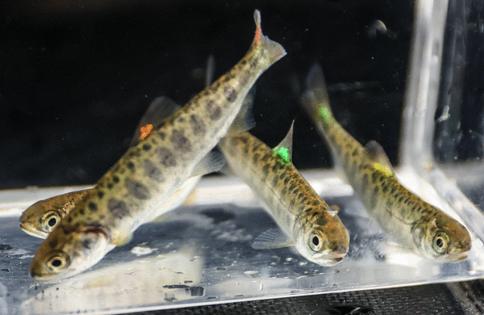Biden administration commits $240 million for hatchery fish amid decline of Pacific NW's wild salmon
Published in News & Features
SEATTLE — As wild salmon runs decline, the Biden administration this week committed $240 million for tribal nations to update hatcheries that have become critical to raising Pacific salmon and steelhead and meeting treaty obligations, especially amid a changing climate.
Today, 14 salmon and steelhead populations in Washington are listed as threatened or endangered under the Endangered Species Act.
An initial $54 million of the hatchery funding will go to 27 tribes in the Pacific Northwest and Alaska to address current hatchery facility upgrades. The tribes are located in Washington, Alaska, Oregon, Idaho and California. Each tribe will be eligible for at least $2 million in funding. The remaining funding will be made available competitively to address an estimated over $1 billion hatchery maintenance and modernization backlog, not for the construction of new facilities.
Tribal nations across the Northwest have been working hard to restore salmon runs. In some places, they’re returning the fish to places they haven’t been in a very long time. The cool water locked behind dams in some watersheds are some of the few remaining opportunities to rescue species from warming waters.
In the Columbia Basin, shad, not salmon, are thriving in the warm, still water created by hydroelectric dams. They on average outnumber Chinook by about four to one. And this summer a record sockeye run has been halted by a wall of hot water at the Okanogan River.
In Puget Sound, the Muckleshoot Tribe and state of Washington have partnered to truck sockeye around Lake Washington, where high water temperatures and disease is estimated to kill about half of the sockeye returning to the Cedar River. Other developed basins with less shade and natural buffers for rivers, like the Snohomish, are some of the most vulnerable to the effects of climate change and have continued to see fishery closures.
Hatcheries are controversial. Previous research has shown hatcheries can have negative impacts on genetic diversity in wild stocks due to interbreeding with hatchery fish, and hatchery fish competing for food and other resources.
Hatcheries provide many of the fish that no longer naturally come from the salmon rivers, impacted by dams and development, said Jennifer Quan, a regional administrator with the National Oceanic and Atmospheric Administration, in a news conference. And more recently, Quan said, hatcheries are becoming a critical adaptation tool for climate change in salmon conservation efforts.
Today, there are about 200 hatchery programs in the Columbia Basin alone and more than 80% of the fish in the river are hatchery fish.
The tribal nations that manage hatcheries have been relying on them to fulfill their own treaty rights to fish. The funding that was promised to help has fallen short of what they need.
For decades, research has shown that what’s really needed to recover wild salmon is habitat restoration, water quality improvements, and adjustments to harvest rates and hatchery practices.
“Society is not willing to fund and make the changes they need to in all of those buckets to recover salmon,” Quan said.
“As we move into climate change … I think the lines are starting to get, from my perspective, blurred on whether hatcheries are bad or good,” Quan continued. “I think hatcheries are situational, and I think we have an opportunity, and we need to start having a conversation about hatcheries and how they are going to be an important adaptation tool for us moving forward.”
The funding announced this week will help tribal nations continue efforts to preserve fish relied upon by ecosystems, wildlife and people, from the mountains to the sea. Over 130 species depend on Pacific salmon. From the caddisflies that feed on their carcasses and in turn feed juvenile salmon, to the seals, sea lions and endangered orcas that slurp up the fish as they head to freshwater, they’re a keystone species, and a good measure of overall ecosystem health.
In addition to hatchery investments, Yakama Nation is taking action to restore salmon in 30 miles of habitat above Cle Elum Dam, where they’ve been cut off for nearly a century. These efforts, which began in 2009, received additional funding from the federal Bipartisan Infrastructure Law and Inflation Reduction Act.
A new structure was recently completed to allow young salmon to migrate downstream past the dam, and fisheries managers have already seen fish successfully use the new route.
Secretary of the Interior Deb Haaland joined Gov. Jay Inslee and state, local and tribal leaders earlier this week to celebrate the return of salmon above Cle Elum Dam and announced another $16 million for projects to address drought in Yakima Basin.
“Our tribes’ motivation is to continue our way of life that we’ve lived for thousands of years as Salmon People,” said Dave Blodgett III, Yakama Nation fisheries manager. “And we’ve relied on our teachings that the salmon took care of us, and so it’s our job to speak on behalf of those that can’t speak for themselves and to continue to take care of those that took care of us.”
Yakama Nation’s fisheries department includes more than 260 staffers across about a third of the state working on everything from removing old culverts and causeways blocking fish passage, to advocacy.
There is still a lot of work to do for salmon, especially in the Yakima Basin, Blodgett said. About 75 sockeye were recently found floating dead in the lower river from a lethal heat wave.
Hatcheries are in many ways a lifeline to salvage the fish stocks that do remain, Blodgett said.
Lummi Nation Councilmember and Northwest Indian Fisheries Commission Vice Chair Lisa Wilson was central in the effort to secure this round of hatchery funding and ensure it reached tribal nations directly.
Lummi operates the only hatchery that raises spring Chinook native to the South Fork of the Nooksack River. The hatchery built more than 50 years ago helped rebuild a population that had fallen to just 19 spawning Chinook in 2004 but is in need of a new intake to draw in the cool waters from the creek.
Wilson said Lummi experiences barriers at every step of the way in efforts to restore salmon. From permitting challenges for habitat projects, to delays in accessing federal funding and tedious grant applications, Wilson likened the barriers to salmon recovery to the barriers salmon themselves face in survival.
“We’re not sitting back saying: where’s our fish? Where’s our salmon? We’re the ones doing all of the work,” Wilson said. “We’re upholding the treaty obligation for ourselves, and then having to jump through all of these hoops — these disproportionate burdens placed on us.”
“In reality,” she continued, “if it wasn’t for the tribes, there wouldn’t be salmon.”
_______
©2024 The Seattle Times. Visit seattletimes.com. Distributed by Tribune Content Agency, LLC.







Comments